A guide for beginner gardeners: how to care for roses in spring
Rose bushes are a unique decoration of any garden plot. They look appropriate both in small flower beds and in chic rose gardens. Agronomists plant shrubs in central Russia, the Moscow region, and southern and northern regions. We will tell you how to care for roses in spring and what to pay special attention to.
Removing covers
Before winter, gardeners cover roses with sawdust, branches or soil. They protect heat-loving flowers from frost and snow.. With the arrival of spring, the shelter is removed. It is important to correctly determine the timing of the procedure. If you leave the shelter too long, the roses will shrink, which will increase the risk of developing bacterial diseases. The rose begins to open at the end of March or beginning of April.
The shelter is removed when stable warm weather sets in and all the snow has melted. The protection is not removed immediately, but gradually - the bushes are ventilated for 2-3 hours daily over the course of a week. Afterwards, the shelter is removed and the plants are shaded with a garden awning or shading film so that they get used to the weather conditions.
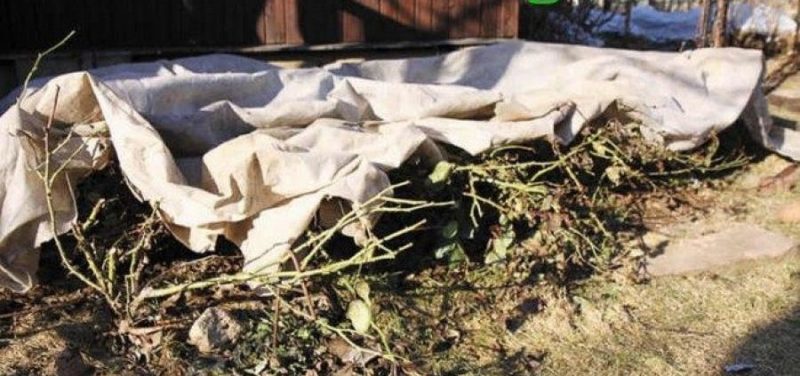
Sometimes, after opening roses, gardeners notice a dirty white film on the shoots. It's not scary, it will disappear in 2-3 days. If some stems are covered with a black coating, it is recommended to remove them. Also, after removing the cover, remove all last year’s leaves and loosen the soil - this will improve the flow of air to the root system.
Identifying and solving problems with bushes
After removing the cover, problems may arise - stains, burns, cracking of the bark.If bright crimson or brown spots are visible on the branches, this indicates an infectious burn that occurred on the bushes under cover during the winter. In this case, gardeners trim the branches to healthy, light-colored tissue. This is necessary to protect the entire bush. After pruning, roses are treated with Bordeaux mixture or copper sulfate solution - 100 g of the drug per 10 liters of water.
Attention! If a break in the bark or cracks are noticed on the bushes, the affected branches are cut into rings; there is no point in treating them. It is better to immediately make room for the growth of new and healthy shoots.
Necessary care for roses in spring
Rose is a fragile and demanding plant to care for. In spring, it is especially important to follow the rules of agricultural technology. Gardeners pay special attention to pruning, fertilizing and mulching.
Trimming
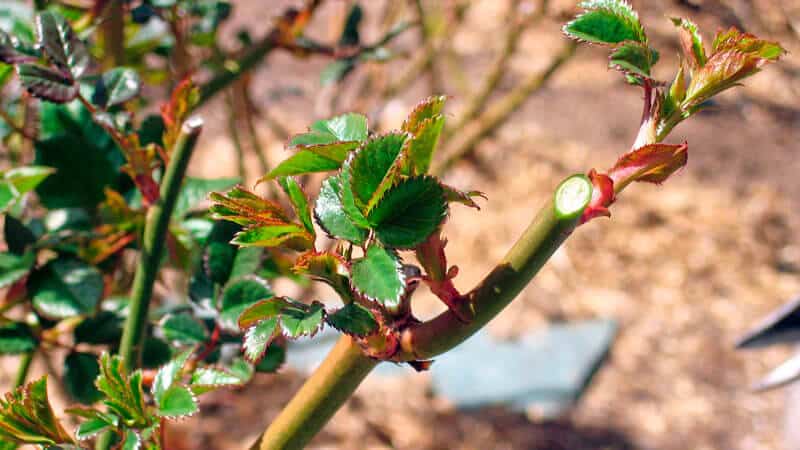
Pruning performs several important functions: gardeners shape the plant, remove old and dry shoots, and stimulate the development of new ones. Thanks to the procedure, the rose is rejuvenated after winter and begins to form flower buds.
Pruning times vary depending on the growing region. Experienced summer residents recommend focusing on weather conditions. It is important that the night frosts disappear and the air temperature warms up to +12°C. It is at this time that the rose buds swell, but the shoots do not grow yet. In cold regions, pruning is carried out in mid-May, in warm regions - in mid or late April.
There are 3 types of rose pruning:
- Rejuvenating. Gardeners make room for young shoots to grow. Old branches are removed to a height of 20 cm. The procedure is carried out only on roses older than 3 years.
- Preventive. It is aimed at eliminating diseased branches and preventing the occurrence of diseases.
- Thinning. Remove old side shoots.
When carrying out the procedure, it is important to follow the rules:
- cut roses with garden pruning shears, otherwise cracks will appear, which will contribute to the growth of bacteria;
- the instrument is disinfected with a solution of potassium permanganate;
- on a dry and warm day, remove all old, diseased, dry, side shoots and shoots growing inside the bush;
- sections are made at a distance of 1 cm above the healthy kidney;
- treat the plants with garden varnish (prepare it yourself or buy it in a store).
Top dressing
Fertilizers promote healthy shoot growth and bud development. The first feeding is carried out at the stage of flower formation, when the rose especially needs nitrogen. Summer residents add 3 kg of rotted manure or 100 g of chicken manure to each bush. Before fertilizing, water the plant generously with warm water.
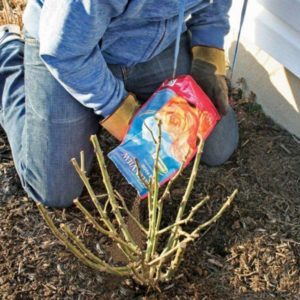
If there is no organic matter in stock, mineral fertilizing is used - 30 g of ammonium nitrate is applied to each bush. For young shrubs, it is recommended to use nitrogen fertilizers in liquid form: 1 tbsp. l. ammonium nitrate is diluted in 10 liters of water and watered at the root of the roses at the rate of 2-3 liters per bush.
The next time the plant is fertilized in May, after 2-3 weeks. This is how summer residents make up for the deficiency of potassium and phosphorus. The first increases the bush’s resistance to fungal and viral diseases, and the second affects the formation of peduncles and buds.
For 1 sq. m add 30-40 g of superphosphate or 15 g of potassium sulfate. Not only the health of the shrubs, but also the appearance of the flowers depends on vitamins and microelements. The next feeding of roses is carried out in the summer.
Attention! A popular and affordable fertilizer for roses is ash solution. It contains phosphorus and potassium. To prepare the fertilizer you need 10 liters of water and 1 tbsp. ash.
Mulching
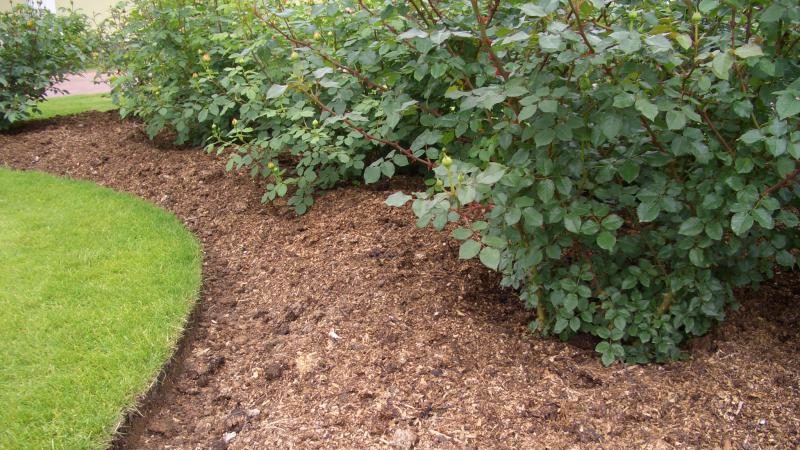
Mulch protects roses from insects and rodents, and also prevents the development of weeds. They use organic matter: peat, ash, pine sawdust, straw and hay, compost. Mulch allows moisture to pass through and retains it at the same time, and has an antiseptic effect.
First, weeds and fallen leaves are removed, and then the soil is covered with a 5 cm thick layer of mulch. The procedure is carried out at any time of the year, but it is preferable to do it in early spring. Mulch decomposes slowly and nourishes the soil, which is beneficial for any garden shrubs.
Some types of mulch also perform a decorative function - the bushes look more well-groomed. For this, gardeners use sawdust, bark, sand, and coffee grounds. In terms of beneficial properties, these components compete with humus and compost, while the plants look original and neat.
Spring protection of roses from diseases and pests
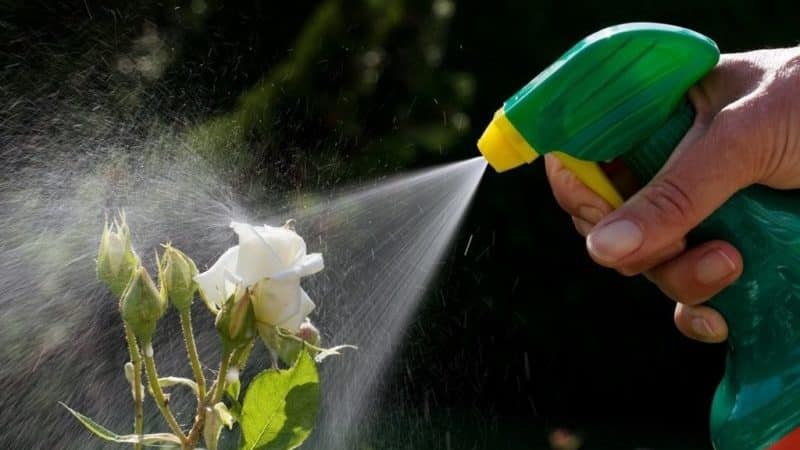
Diseases and pests arise for various reasons: due to sudden changes in weather, contaminated planting material or soil. To protect roses, summer residents carry out preventive measures - they treat the plants with a solution of copper oxychloride (4%) or a suspension of colloidal sulfur (1%).
The following mixture is used against powdery mildew and rust: 300 g of grated laundry soap is diluted in 9 liters of warm water. At the same time, prepare a solution of copper sulfate - 30 g of the drug per 1 liter of water. The two formulations are mixed and sprayed on roses from a spray bottle every 10 days.
To protect shrubs from insects (aphids, leaf rollers, spider mites), watering with wormwood tincture is used. For preparation, take 400 g of fresh leaves and 50 g of dried leaves. The leaves are poured into 10 liters of cold water and infused for 2 weeks.Before use, the solution is diluted with water in a ratio of 1:10. To enhance the effect, you can add 100 g of liquid soap to it.
Attention! When affected by bacterial or fungal diseases, gardeners remove diseased leaves and shoots and burn them. Otherwise, this may lead to the death of other rose bushes and plants planted nearby.
Features of spring care for young and old roses
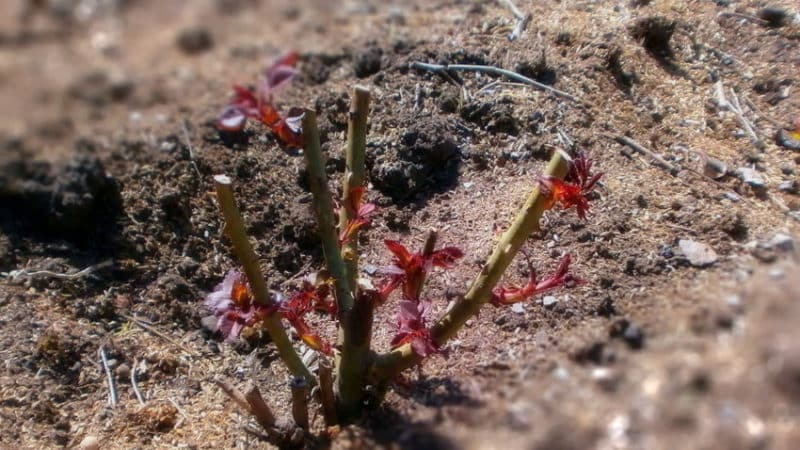
Young roses are sensitive to temperature changes and waterlogging. To protect the bushes from possible spring frosts, it is recommended to compact the soil at the base of the plant and sprinkle it with purified river sand.
To water young roses, use melted or settled water at room temperature. Cold watering will lead to the development of bacteria and fungi. The roots cool and lose their ability to absorb moisture. When applying fertilizers to young plantings, it is important to maintain the proportions of nutrients. If the leaves of a bush are covered with yellow-gray spots, this indicates an excess of microelements.
Attention! It is not recommended to cut flowers for bouquets from young roses, especially those with leaves. This may result in slower bud formation next year.
Old roses are demanding of moisture; if there is a lack of it, the bushes shed their leaves. Climbing roses that grow near buildings especially need moisture. You should not take water from open sources, as pathogens live in it. In addition to root feeding of old roses, gardeners pay attention to foliar spraying - the plants are treated with Bordeaux mixture. It is important that the soil around the bush is loose.
For grafted and feral
Rose hips are mainly used for grafting roses.. In the first years, such shrubs are not fed; attention is paid to watering and mulching. In the second year in the spring, the grafted plant is pruned and mineral fertilizers are applied. The shoots are shortened by 10-15 cm, and the old and dead ones are removed entirely. The second time the procedure is carried out in the summer, after flowering.
All branches are pruned at a height of 35-40 cm. From April, the bushes are inspected for spots and damage, since it is at this time that aphids actively manifest themselves. Young foliage of wild roses is sprayed with fungicides or folk remedies - infusion of nettle or tansy. Shrubs are treated once every 15 days.
The nuances of caring for roses depending on the growing region
In regions with an unstable climate (for example, in the Urals and Siberia), roses need special nutrition. Shrubs respond well to fertilizing with complex fertilizers. They contain mineral and organic substances and are easy to prepare and use. Summer residents use "Tsitovit". It contains nitrogen, phosphorus, potassium, zinc, copper, molybdenum and cobalt. The drug improves metabolism, reduces ovary abscission and increases resistance to diseases. The fertilizer dissolves well in water and does not cause plant burns; it is used for both old and young roses.
In warm areas, the soil is loosened after watering or rain. The distance from the base of the bush should be at least 6 cm so as not to damage the root system. If the weather is dry and hot outside, water the rose once every 5-7 days. If it rains and the weather is humid - once every 10-12 days.
Planting new roses in spring
If you plant roses in the spring, they are less susceptible to frost. Over the summer, they build up the root system, the wood ripens, and the shoots grow stronger. When planting, use purchased cuttings.
How to plant
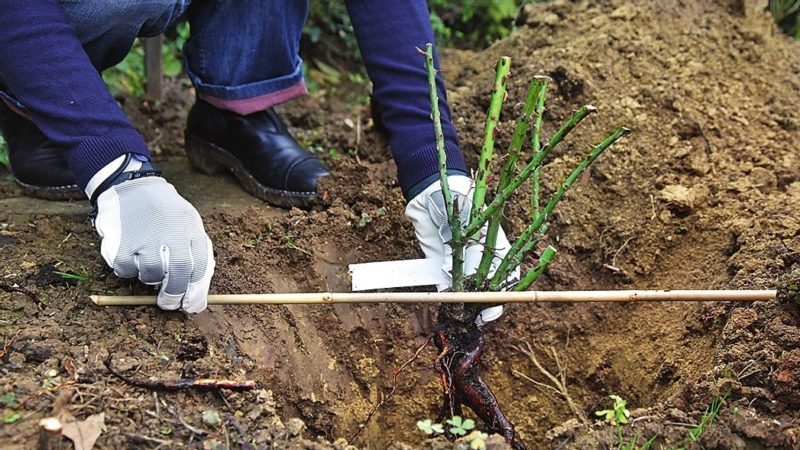
Roses grow well in southwestern areas with a slight slope. The place should be protected from the wind, sunny and well lit; in the shade the bushes develop slowly. Roses love fertile soil - acidic and wet soils are not suitable. The distance between bushes is at least 50 cm.
The depth of the planting hole is 60 cm, diameter is 50 cm. The top layer of soil is mixed with ash or river sand to make the soil looser and lighter. If groundwater is close to the site, a drainage layer of crushed stone or pebbles is laid at the bottom of the hole. The roots of the seedlings are dipped in a clay mash, placed in a hole, straightened and sprinkled with earth. The final stage of planting is moistening.
When to plant roses in open ground
The right time is from mid-April to early May. Planting too early in March will cause the seedlings to freeze. The timing depends on the region, so it is recommended to pay attention only to weather conditions. You should not plant shrubs if the snow has not yet melted and warm weather has not set in.
Further care
Further care for roses consists of standard procedures: watering, fertilizing, loosening, mulching. During the summer, organic and mineral fertilizers are applied under the bushes, after moistening the soil. Every 2-3 weeks, plants are sprayed with a solution of copper sulfate or Bordeaux mixture to protect against diseases and pests. During the flowering period, make sure that there are no aphids and spider mites on the leaves and shoots.
In the fall, they begin preventive pruning to prepare the plant for winter. Remove weak shoots and cover the bush with sawdust or earth. Manure is also added before winter so that the roses can withstand cold and wind.
This is interesting:
A guide to cutting roses in the fall at home for beginning gardeners
How to care for a home rose in a pot - a guide for beginner gardeners
Instructions for beginner gardeners: how to root a rose from a bouquet at home
Advice from experienced flower growers
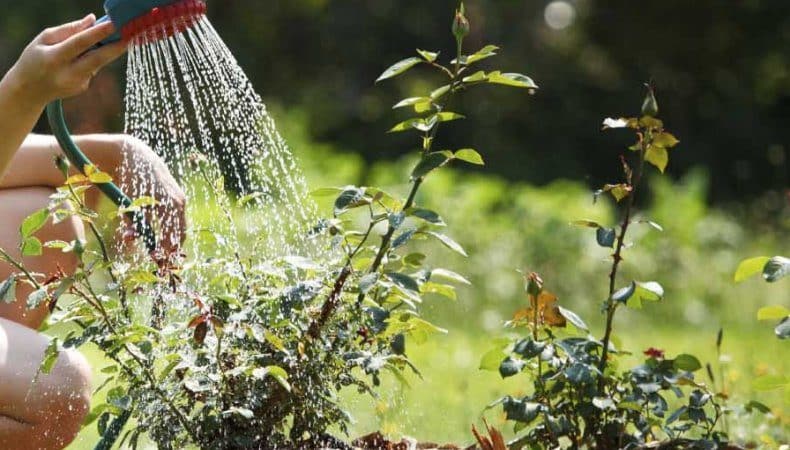
To decorate your garden with bright and beautiful shrubs, we recommend listening to experienced gardeners. Simple rules will help protect roses from diseases in the garden and at the dacha, and will also extend their lifespan:
- plant shrubs in the morning on a cloudy day;
- Treatment with Fitoverm will help protect against insects;
- during pruning, remove not only old but also frozen shoots;
- Do not use fresh manure for feeding, only rotted manure;
- Lack of nutrition is just as harmful as excess - it is important to follow dosages and instructions;
- Rose does not grow well in acidic soils, so sprinkle the soil with dolomite flour before planting.
Conclusion
Spring rose care begins with removing the cover. Sawdust or soil is removed gradually so that the plant gets used to weather conditions. Then they begin pruning - removing diseased and dry branches to make room for new shoots.
In April, the first feeding is carried out - mineral or organic fertilizers are applied. They promote plant development and normalize metabolism. Rotted manure, a solution of bird droppings, superphosphate or urea are used. Water the roses with water at room temperature, regularly loosen the soil and mulch it with sawdust, hay, and sand.